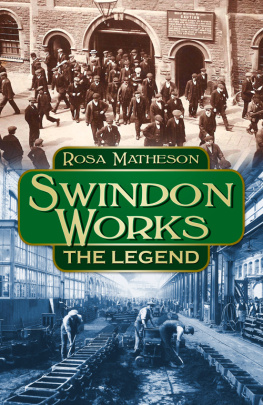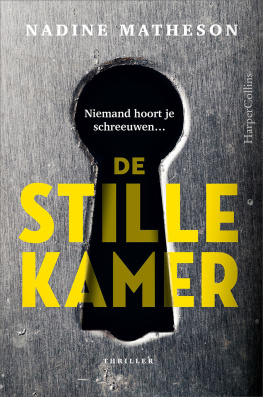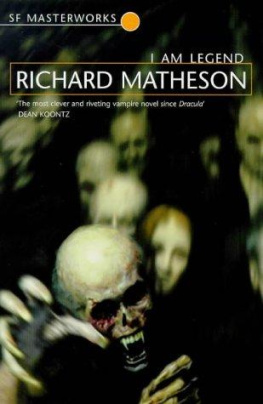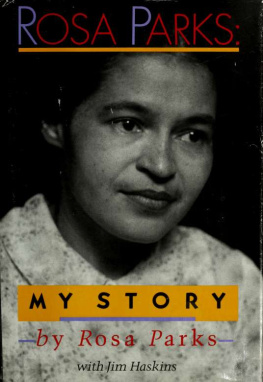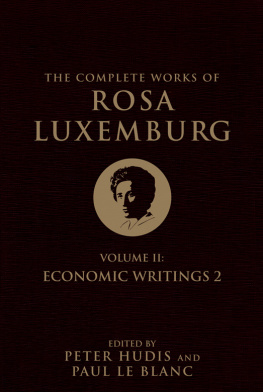Matheson Rosa - Swindon Works
Here you can read online Matheson Rosa - Swindon Works full text of the book (entire story) in english for free. Download pdf and epub, get meaning, cover and reviews about this ebook. year: 2016, publisher: The History Press, genre: Science. Description of the work, (preface) as well as reviews are available. Best literature library LitArk.com created for fans of good reading and offers a wide selection of genres:
Romance novel
Science fiction
Adventure
Detective
Science
History
Home and family
Prose
Art
Politics
Computer
Non-fiction
Religion
Business
Children
Humor
Choose a favorite category and find really read worthwhile books. Enjoy immersion in the world of imagination, feel the emotions of the characters or learn something new for yourself, make an fascinating discovery.
- Book:Swindon Works
- Author:
- Publisher:The History Press
- Genre:
- Year:2016
- Rating:4 / 5
- Favourites:Add to favourites
- Your mark:
- 80
- 1
- 2
- 3
- 4
- 5
Swindon Works: summary, description and annotation
We offer to read an annotation, description, summary or preface (depends on what the author of the book "Swindon Works" wrote himself). If you haven't found the necessary information about the book — write in the comments, we will try to find it.
Swindon Works — read online for free the complete book (whole text) full work
Below is the text of the book, divided by pages. System saving the place of the last page read, allows you to conveniently read the book "Swindon Works" online for free, without having to search again every time where you left off. Put a bookmark, and you can go to the page where you finished reading at any time.
Font size:
Interval:
Bookmark:

I always love this part of the book, acknowledging the kind and generous help given by friends old and new. It pleases me that my books are a collaboration of shared passion.
So once again warm appreciation goes to Elaine Arthurs, archivist at STEAM Museum of the Great Western Railway; to Daryl Moody, Lead, Local Studies at Town Centre Library; and Sophie Cummings, Curator at Swindon Museum and Art Gallery. All couldnt have been more helpful. Thanks to Wiltshire and Swindon History Centre and to those at St Johns Ambulance HQ.
BIG thanks to good friends and fellow authors who always give encouragement and assistance Rev. Canon Brian Arman, Ken Gibbs and Andy Binks. Special thanks to John Walters and Bob Townsend, whose knowledge, resources and generosity have helped many books be achieved, mine included; not forgetting the Thursday morning gang in STEAM Museum and those at the Thursday Railwaymen/womens Club; as always, couldnt have done it without you. Thanks also to the enthusiasts who let me quote from their websites John Ward, Andrew Grantham and Brian Basterfield. Special thanks to my mate-in-crime, Jack Hayward, always there for me no matter what, and to the Friends on Swindon Works Training School Facebook page for their enthusiasm and responsiveness. An acknowledgement of the work of Alfred Williams must also be added.
Appreciation to my commissioning editor, Amy Rigg, for her boldness and willingness to help make this happen and my publishers for their sense of adventure in trying something new. As writers and publishers of history we have, I believe, a duty to bring this history to new and younger audiences, as well as faithful followers, so that the history of their forebears will not be lost so we try something new.
The last thanks, as always, go to my wonderful family for their continued support and interest in my railway work, particularly grandson Evan, whose passion for railways diesels, signals and points and signal boxes gives us both a great deal of pleasure.
T HE B EGINNING
The starting point was the fact that the Great Western Railway Company was in need of a factory to repair its bought-in locomotive rolling stock. The Board of Directors gave the task of finding the location for such an establishment to their young engineer Isambard Kingdom Brunel and he gave the job to Daniel Gooch, his assistant but who was to become the first Locomotive Superintendent at Swindon Works. In the words of Daniel Gooch:
1840. During this year further portions of the Great Western were opened and agreements were made for leasing the Bristol and Exeter and the Swindon and Cheltenham Railways, and it became necessary to furnish large works for the repair, etc., of our stock. I was called upon to report on the best situation to build these works, and on full consideration I reported in favour of Swindon, it being the junction with the Cheltenham branch and also a convenient division of the Great Western line for the engine working. Mr. Brunel and I went to look at the ground, then only green fields, and he agreed with me as to its being the best place.

1841 plan.
Gooch then wrote to Brunel in September 1840 that, having put his mind to the task of the best site for the principal engine establishment and having studied the convenience of the Great Western Railway, only:
an engine establishment at Swindon commensurate with the wants of the Company, where a change of engines may be advantageously made The establishment there would also comprehend the large repairing shops for the Locomotive Department.

J.C. Bournes iconic lithograph of the engine house at Swindon in 1846. A Firefly class locomotive stands on the traverser receiving attention from the mechanicals or mechanicians.
His recommendation was endorsed by the directors, who on 25 February 1841 authorised the construction of such a depot at Swindon in the following words:
Decide to provide an engine establishment at Swindon commensurate with the wants of the Company, where a change of engines may be advantageously made and the trains stopped for the purpose of passengers taking refreshment. The establishment there would also comprehend the large repairing shops for the Locomotive Department.
and sometime shortly after, work began.

In the words of Works employee, Alfred Williams , as stated in the title of his iconic book (1915), it was simply:
The Railway Factory.
In the words of Sir Daniel Gooch , then Locomotive Superintendent, in 1847:
Swindon [Works] has been designed and built to employ 1,8002,000 men, and all the arrangements of tools and shops have been made to employ that number of men to the best advantage
For most the Works is always thought of in three sections Locomotive. Carriage. Wagon. Locomotive came first. Carriage and Wagon came together later, and so are always said in one breath but, in the words of Astills Almanac and Trade Guide : New Swindon 1872 it is something other:
The G.W.R. Railway Works are situated on the north side of the Main Line. The three Establishments constituting what is known as the Works, viz: The Locomotive Works , The Carriage Manufacturing Department , and The Rail Mills are carried on under one general management and are unique in their arrangements.
In the words of the Companys General Manager Frank Potter in 1910:
Swindon [Works] throughout the Great Western Railway and in many other quarters beside, is a synonym for all the qualities and characteristics which were associated with the broad-gauge thoroughness, solidity and substantiality and the expression of that idea is to be found today, in this, the seventy-fifth year of the GWR, wherever the locomotives, the vehicles, or appliances of any kind, manufactured at Swindon, are in use. It does not matter how small or comparatively trifling the article maybe, if it has been made at Swindon, it needs no legend to be stamped upon it to indicate the place of its origin or manufacture.
In the words of Mrs Violet Joynes , who worked Inside during the Second World War, it was:
A town within a town it had its own buses and bus stops even!
In the words of two who worked there in its dying decades of the 1970s and 80s:
Nigel George : The centre of a much loved empire.
Mark Buckley : An engineering and manufacturing powerhouse; a school of knowledge; a family. A way of life!
Whilst in the words of Ian Williams (the great-great nephew of the aforesaid Alfred Williams):
The Works was one huge storybook where almost everyone knew everyone someway or other.
Swindon Works was originally a depot for stabling engines which were changed at Swindon before the train continued on to Bristol; its workshops were for their maintenance and repair work.
Swindon Works was Great Western Railway Company (1841), British Railways Western Region (1948), British Railway Workshops (1962), British Railway Engineering Ltd (1970).
Swindon Works was Broad Gauge, Standard Gauge, Steam and Diesel.
Font size:
Interval:
Bookmark:
Similar books «Swindon Works»
Look at similar books to Swindon Works. We have selected literature similar in name and meaning in the hope of providing readers with more options to find new, interesting, not yet read works.
Discussion, reviews of the book Swindon Works and just readers' own opinions. Leave your comments, write what you think about the work, its meaning or the main characters. Specify what exactly you liked and what you didn't like, and why you think so.

